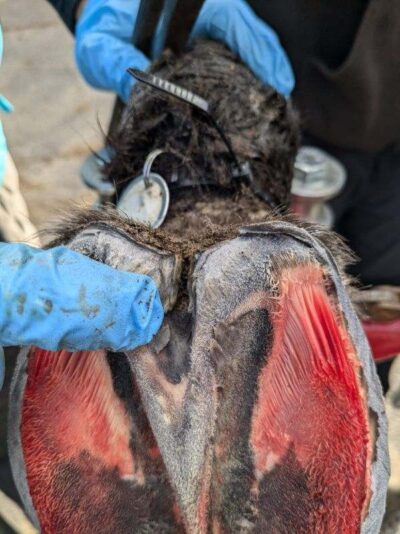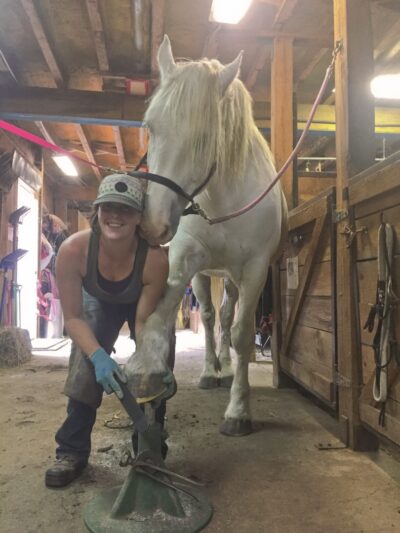single learning post
Advanced Anatomy and Radiographs – Quebec
This clinic fulfills the PHCP radiograph requirement for students enrolled in the training program.
Day 1 – Advanced Anatomy and Morphology
Dissection and exploration of the internal and external structures of the foot.
We will start with a short review of anatomy; however, participants will benefit greatly from having a basic understanding of the internal and external structures of the foot prior to attending.
The dissection will be led by the instructor but students will be hands on in helping with the the different stages of the dissection. We will pick two to four hooves that have different morphologies. The number of hooves we dissect may vary depending on what we find and how long we spend with each one. We will compare the differences between healthy and unhealthy structures in each foot. We will learn how to visualize where our internal structures are positioned by reading external landmarks.
Examples of common pathologies we will see may include deep sulcus thrush affecting the frog corium, stretched weak lamina, white line infection, wall cracks, P3 remodeling that is visible externally, wall delamination, abscesses, and thin soles.

Participants will go home with the following abilities to:
- Assess the health of the soft tissue structures in the back of the foot (digital cushion, lateral cartilages, frog corium).
- Assess and accurately estimate sole depth and medio-lateral balance.
- Assess palmar/plantar angles.
- Pinpoint the center of rotation of the coffin joint.
- Assess P3 position in relation to toe length.
- Read wear and loading patterns in untrimmed feet. We will speculate on whether the wear we see is static (postural) vs dynamic (created during movement).
Day 2 – Radiograph Guided Trimming and Dissection
To participate in Day 2 you must attend Day 1 of this clinic.
We will use the assessment techniques learned in Day 1 – Advanced Anatomy to make trimming decisions. We will do a basic introduction to reading radiographs before we begin the exercise. Feet will be radiographed prior to trimming, and again post trim. We will be able to critically assess how our trim impacts the position of the hoof capsule in relation to the bony column. Each participant will then complete a self-guided dissection/exploration of their foot.

Prerequisite
Attending a PHCP Anatomy & Trimming clinic is highly recommended to get the most out of this clinic. Maia will be offering the Anatomy, Trimming and Hoof Protection clinic the weekend before this clinic.
Paige Poss and Jenny Edward’s Anatomy of the Equine online hoof course is highly recommended for beginners and professionals alike.
What to bring
Coffee tea and snacks will be provided. A wide variety of lunch options are available within 5 minutes of venue.
Dissection tools will be provided. Please bring trimming tools, work gloves and dress appropriately for the weather as some work may be done outdoors.
Accommodations
A list of accommodations and other details will be sent to registered participants.
 Maia Chaput is a PHCP certified practitioner, mentor, and clinician. Her specialties include helping horses grow healthy strong bare feet; preventing and rehabilitating common hoof related lameness issues, including laminitis and navicular. She uses hoof boots and composite shoeing as alternatives to traditional metal shoeing when horse’s feet are in of need of support. Maia is passionate about educating and empowering horse owners to play an active role in all of the above, as well as mentoring the next generation of hoof care practitioners through their certification process.
Maia Chaput is a PHCP certified practitioner, mentor, and clinician. Her specialties include helping horses grow healthy strong bare feet; preventing and rehabilitating common hoof related lameness issues, including laminitis and navicular. She uses hoof boots and composite shoeing as alternatives to traditional metal shoeing when horse’s feet are in of need of support. Maia is passionate about educating and empowering horse owners to play an active role in all of the above, as well as mentoring the next generation of hoof care practitioners through their certification process.
Type Hands-on
With Maia Chaput
Where Rigaud, QC
When
Cost $350, $450 non-member
Credits 16
/ Status Currently unscheduled.
All clinics
- Anatomy, Trimming and Hoof Protection – Colorado
- WTF (What the Founder) – Part 1
- Hands-on Reading Radiographs for the Hoof Care Practitioner
- WTF (What the Founder) – Part 2
- The Smart Way to Feed Horses – Part 1
- The Smart Way to Feed Horses – Part 2
- How to Create and Manage Your Track System
- Reading Radiographs for the Hoof Care Practitioner
- Anatomy, Trimming and Hoof Protection – New York
- Documenting Hoof Rehabilitation
- Advanced Anatomy and Radiographs – Colorado
- Anatomy, Trimming and Hoof Protection – California
- Sustaining Your Hoof Care Business
- Anatomy, Trimming and Hoof Protection – Tennessee
- Advanced Anatomy and Radiographs – Tennessee
- Off to a Good Start: Trimming Foals
- Trimming Donkeys: Trimming Protocol, Hoof Distortion, and Laminitis
- Anatomy, Trimming and Hoof Protection – Florida
- Anatomy, Trimming and Hoof Protection – Quebec
- Feeding Performance Horses
- Feeding Pregnant and Growing Horses
- Feeding for Special Needs
- Hyperinsulinemia, Laminitis, and PPID: Diagnosis and Management
- Limb Conformation, Body Posture and Hoof Capsule Distortions
- Collaboration Between Hoof Care Professionals & Equine Bodyworkers
- Dr. Bowker on Sound versus Healthy Hooves
- Changes in Coffin Bone Structure and Influence of Trimming
- Wear Patterns, What They Really Mean!
- Starting Your Hoof Care Business
- Dr. Tomas Teskey on the Equine Dental-Body Connection
- Choosing and Fitting Hoof Boots
- EMS (IR) and PPID: Diagnosis and Management
- Paige Poss Explores Hoof Distortions and Hoof Related Pain
- Utilizing Hoof Imaging in your Trimming Decisions
- Equine Biosecurity; It’s All About Prevention
- Genetics of Equine Metabolic Syndrome and Laminitis Risk
- Basics of Reading Radiographs
- NRC Plus
- Cushing’s and Insulin Resistance
All of our educational offerings are open to the public.

